Devil’s Canyon Review: Intel Core i7-4790K and i5-4690K
by Ian Cutress on July 11, 2014 10:00 AM EST- Posted in
- CPUs
- Intel
- Haswell
- i7
- Overclocking
- Devil's Canyon
- i5
- 4790K
- 4690K
CPU Benchmarks
The dynamics of CPU Turbo modes, both Intel and AMD, can cause concern during environments with a variable threaded workload. There is also an added issue of the motherboard remaining consistent, depending on how the motherboard manufacturer wants to add in their own boosting technologies over the ones that Intel would prefer they used. In order to remain consistent, we implement a OS-level unique high performance mode on all the CPUs we test which should override any motherboard manufacturer performance mode.
HandBrake, SD Film: link
For HandBrake, we take two videos (a 2h20 640x266 DVD rip and a 10min double UHD 3840x4320 animation short) and convert them to x264 format in an MP4 container. Results are given in terms of the frames per second processed, and HandBrake uses as many threads as possible.
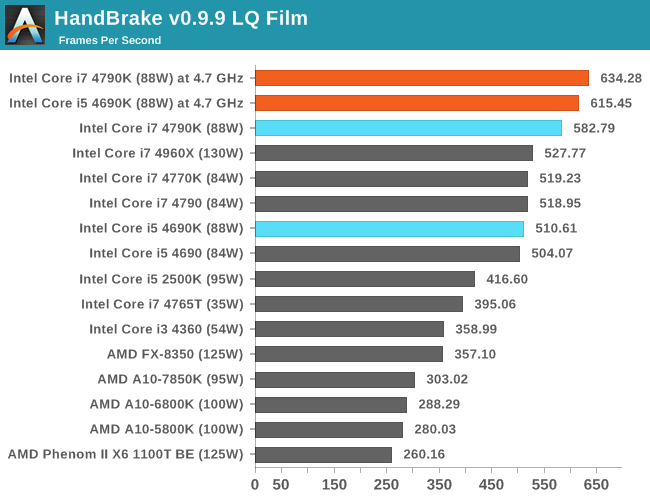
HandBrake, 4K60 Animation: link
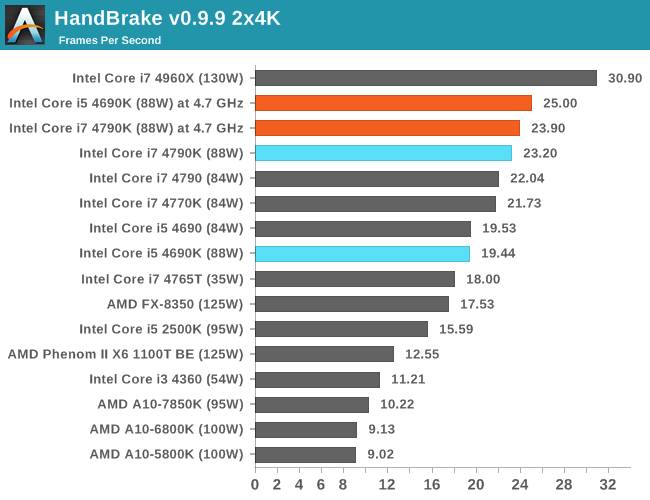
Agisoft Photoscan – 2D to 3D Image Manipulation: link
Agisoft Photoscan creates 3D models from 2D images, a process which is very computationally expensive. The algorithm is split into four distinct phases, and different phases of the model reconstruction require either fast memory, fast IPC, more cores, or even OpenCL compute devices to hand. Agisoft supplied us with a special version of the software to script the process, where we take 50 images of a stately home and convert it into a medium quality model. This benchmark typically takes around 15-20 minutes on a high end PC on the CPU alone, with GPUs reducing the time.
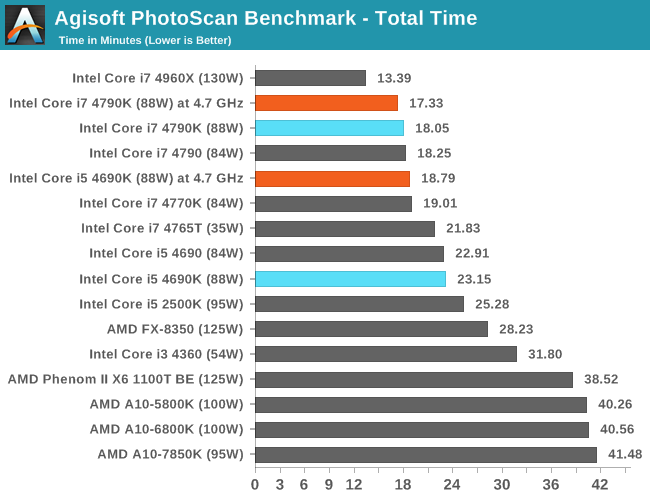
Dolphin Benchmark: link
Many emulators are often bound by single thread CPU performance, and general reports tended to suggest that Haswell provided a significant boost to emulator performance. This benchmark runs a Wii program that raytraces a complex 3D scene inside the Dolphin Wii emulator. Performance on this benchmark is a good proxy of the speed of Dolphin CPU emulation, which is an intensive single core task using most aspects of a CPU. Results are given in minutes, where the Wii itself scores 17.53 minutes.
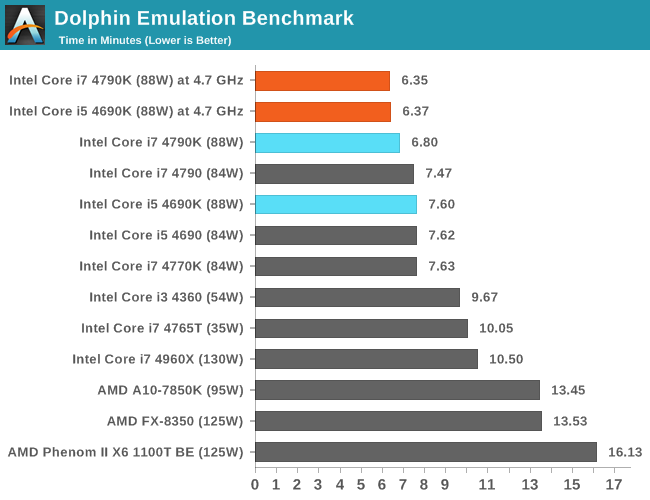
WinRAR 5.0.1: link
This test compresses a set of 2867 files across 320 folders totaling 1.52 GB in size – 95% of these files are small typical website files, and the rest (90% of the size) are small 30 second 720p videos.
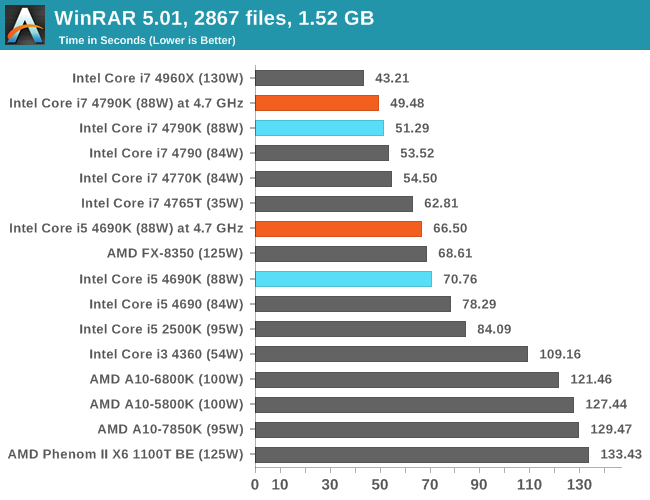
PCMark8 v2 Work 2.0 OpenCL on IGP
A new addition to our CPU testing suite is PCMark8 v2, where we test the Work 2.0 and Creative 3.0 suites in OpenCL mode. As this test is new, we have not run it on many AMD systems yet and will do so as soon as we can.
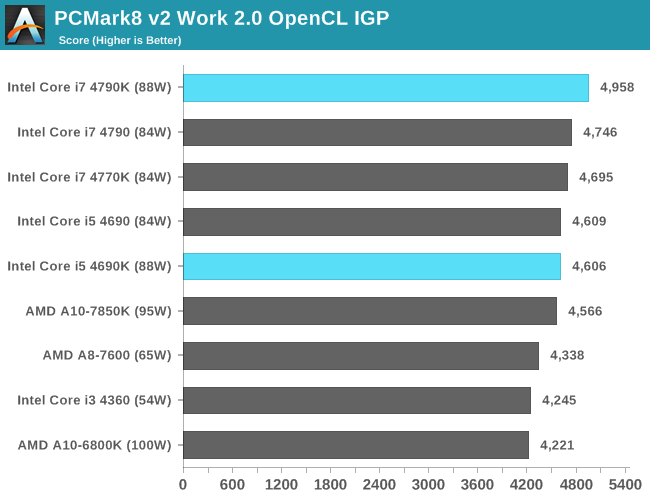
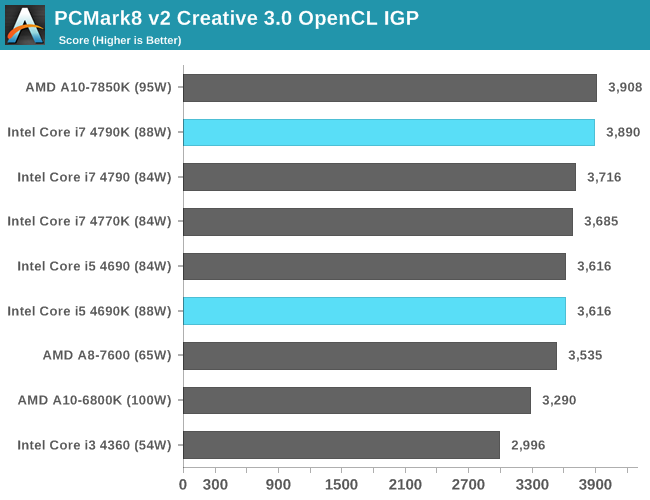
Hybrid x265
Hybrid is a new benchmark, where we take a 4K 1500 frame video and convert it into an x265 format without audio. Results are given in frames per second.
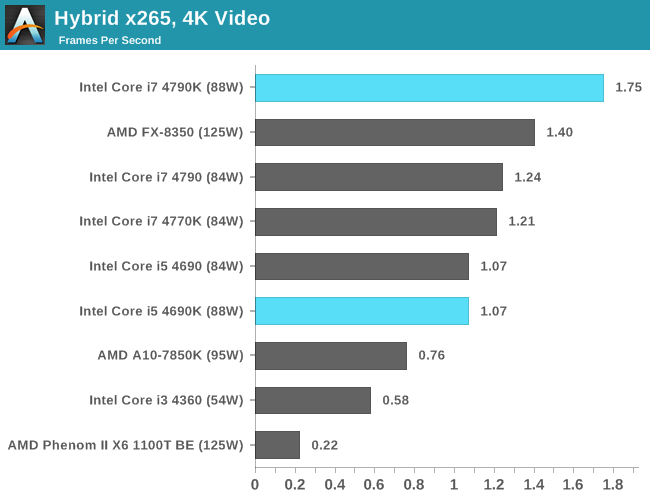
Cinebench R15
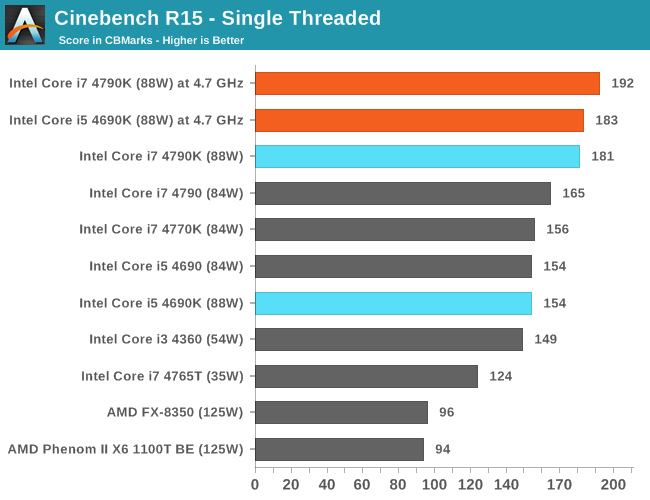

3D Particle Movement
3DPM is a self-penned benchmark, taking basic 3D movement algorithms used in Brownian Motion simulations and testing them for speed. High floating point performance, MHz and IPC wins in the single thread version, whereas the multithread version has to handle the threads and loves more cores.
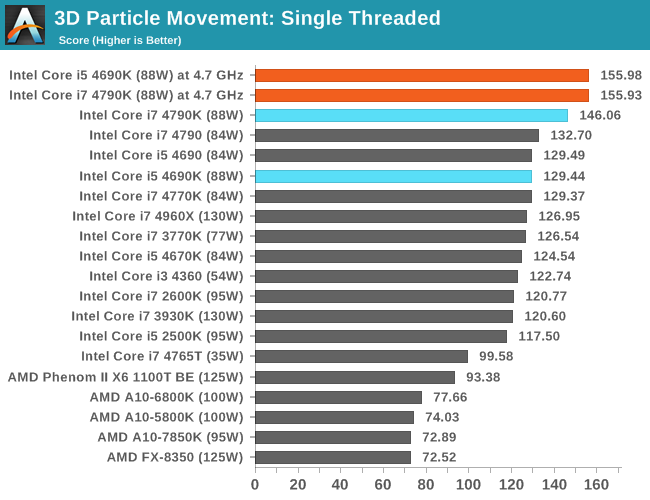
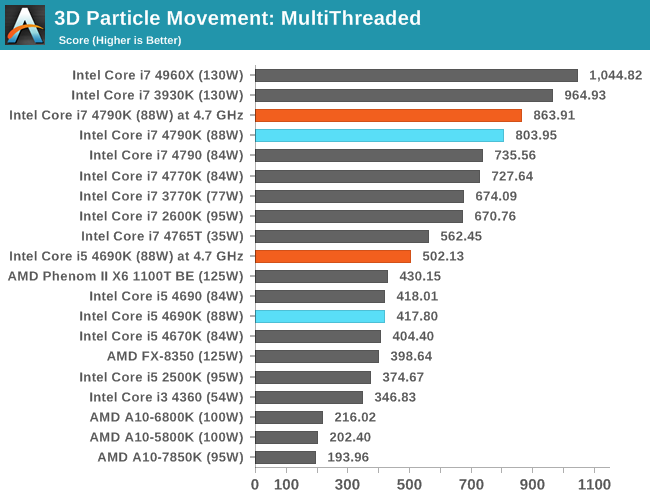
FastStone Image Viewer 4.9
FastStone is the program I use to perform quick or bulk actions on images, such as resizing, adjusting for color and cropping. In our test we take a series of 170 images in various sizes and formats and convert them all into 640x480 .gif files, maintaining the aspect ratio. FastStone does not use multithreading for this test, and results are given in seconds.
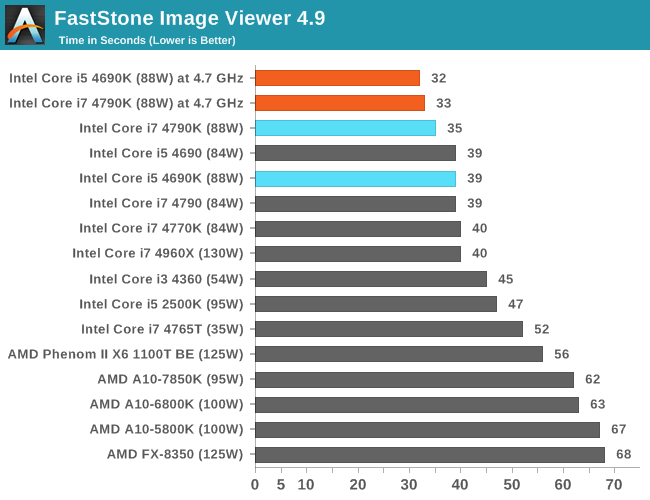
All of our CPU benchmarks are responsive to more frequency, and for tests that are all about single threaded performance (3DPM-ST, FastStone, Dolphin), the overclocked processors match each other. The highly clocked i7-4790K at stock is taking the lead in each of these benchmarks against the other processors at stock frequencies quite easily. For multi-threaded scenarios, it is interesting to note that when overclocked, Handbrake does not seem to use the extra threads that efficiently when encoding 4K60. This is presumably because each thread needs a fair amount of cache and there is little speed-up in switching the work between threads.










117 Comments
View All Comments
maximumGPU - Friday, July 11, 2014 - link
Thanks for the info!xeizo - Friday, July 11, 2014 - link
I quit overclocking this generation, I have a SB 2600K that does 5GHz+ stable for 24/7 operation if needed and it sits fine in my gaming rig. But, Haswell is interesting exactly for that 24/7 operation thing, I like to have my home server always on and it doubles as a Linux workstation. The lowest end i5 aka 4570S is perfect for that kind of use, very conservative power draw means great opportunities for a silent rig and at the same time snappy enough performance for almost all tasks. I did some bclk on mine so that it turbos to 3.83GHz and it has fast 2133MHz memory. And it is virtually silent and very cool(max 50C at 4x100%). It replaced a Q9450 and was quite a big upgrade in all aspects, so Haswell has it's points other than maximum performance at any cost.My gaming rig waits sceptically for Haswell-E, looks more to be Maxwell frankly speaking ...
jihe - Saturday, July 12, 2014 - link
I quit overclocking when one has to pay a premium to do it. Long live FSB and BCLK overclocks.ZeDestructor - Monday, July 14, 2014 - link
Everything LGA2011 i-series is unlocked ;)Ofc, if you're going there, you have other reasons for doing so, not just overclocking.
PICman - Friday, July 11, 2014 - link
Would you please elaborate on the relationship between outer shell electrons and thermal conductivity? Is more better?Incidentally, polymers have poor thermal conductivity. Nearly all of the thermal flux is due to the filler (composition, concentration, aspect ratio).
ZeDestructor - Friday, July 11, 2014 - link
From what (admittedly little) I know about chemistry, outer-shell electrons don't matter much in thermal conductivity. Not here at least, since they are not free (and thus electron motion heat transfer (can't remember the proper name)isn't possible as in pure metals and alloys). All they would do is change the colour of the TIM as well as other properties of the associated salt (oxides are a specific type of salt).If you check back around Sunday evening/Monday morning, I may update this thread: I have a DnD game with some chemist friends who may be able to answer that question, and well, is a mildly interesting question.
PICman - Friday, July 11, 2014 - link
ZeDestructor, thanks, but I was being sarcastic. Thermal conductivity is much more complex than simply counting valence electrons. Note that a diamond (carbon has 4 valence electrons) is the best solid non-conductive material. Liquids and conductive solids (like silver or copper) are a different story.Ian Cutress - Friday, July 11, 2014 - link
The outer shell d-electrons was more a comment towards color. A number of d10 oxides are used as pigments for paint due to their strong white color. If the ceramic matrix suspension had been something more vibrant, we might be able to pin it down easier. But you don't see any Vanadium based TIMs anywhere :DThermal conductivity usually benefits from rigidity of the material. Hence why diamond is good and a sponge is bad. If you want the best thermal conductivity between the CPU and heatsink, then something like Coollaboratory Liquid Ultra, which uses a binding metal (Gallium, which eats Aluminium - check Youtube for videos) to reform between the two metal surfaces and bind them. This binds the heatspreader to the heatsink (or the die to the heatspreader) without any chance of removal without severe force.
http://www.coollaboratory.com/en/products/liquid-u...
DiDaDaDi - Friday, July 11, 2014 - link
Does anyone knows why 4670k/4770k had TSX/VT-d removed? Of course apart from the obvious reasonDanNeely - Friday, July 11, 2014 - link
They consider it an Enterprise feature and don't want enterprise customers buying cheap consumer CPUs and Overclocking them for more performance when they could force them to buy Xeons for ten times as much.